By cherry-picking a single metric, RT DE attempts to claim greater legitimacy in German media market
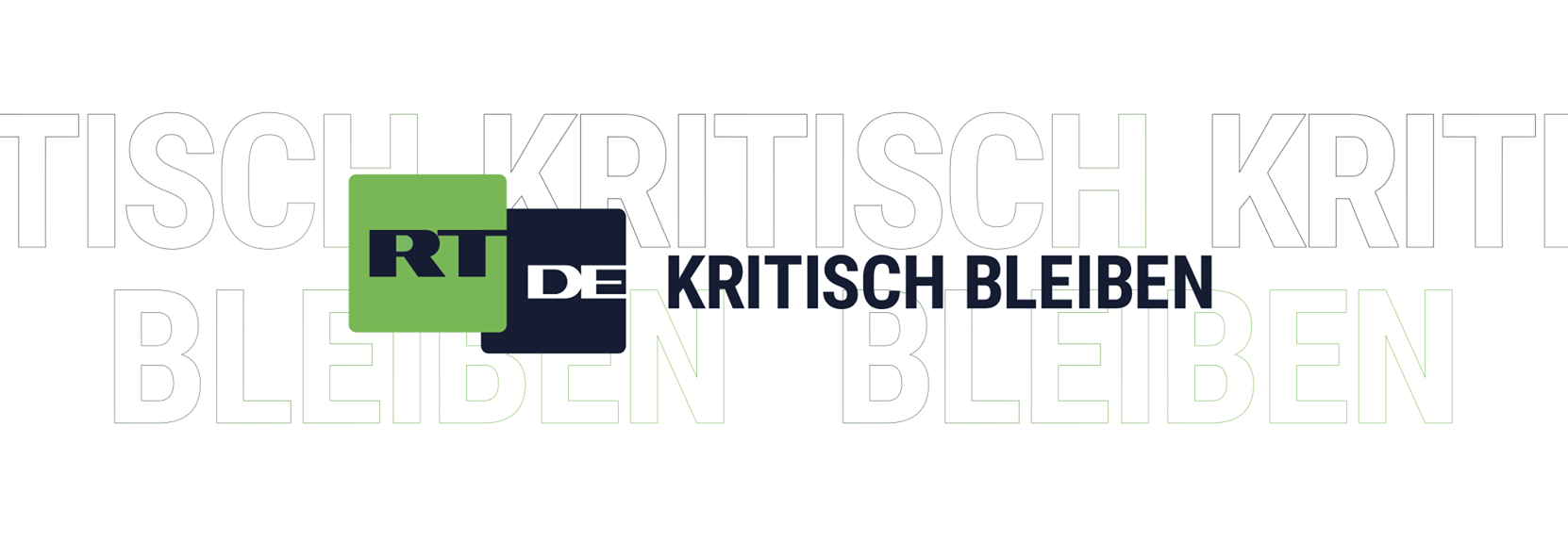
By Givi Gigitashvili
Dinara Toktosunova, the editor-in-chief of RT DE, the German-language subsidiary of Kremlin-owned media outlet RT, cherry-picked a single digital analytics metric to inflate the subsidiary’s profile relative to other German outlets.
Although Toktosunova tried to position RT DE’s TV channel as more popular on digital platforms than many renowned local TV channels in Germany, a closer look at various performance metrics for RT DE on YouTube and Facebook showed that singling out one particular metric does not fully capture how it performs against other German TV channels. German TV channels that garnered fewer views of videos than RT DE YouTube channel and Faceboook page in June 2021 also outperformed RT DE on other metrics.
On July 26, 2021, Toktosunova posted on Telegram that RT DE garnered 21.3 million views on YouTube in June 2021, while local German outlets such as Tagesschau, ZDF, and Deutsche Welle “were left behind.” Toktosunova’s post also declared that RT DE was fifth in Germany in terms of the total number of Facebook video views in June 2021. Margarita Simonyan, RT’s editor-in-chief, shared Toktosunova’s Telegram post to her own channel and added that RT DE had 21 million views in June 2021, while Deutsche Welle had just 5 million, and the latter would have to “live with that.”
Media companies exploiting digital metrics for commercial gain and bragging rights is nothing new, of course; outlets routinely track their performance for calculating potential advertising revenue, as well as for purely competitive purposes. In this instance, there is certainly competition at play, but not just over market dominance. By claiming RT DE is beating its competition in the digital space, Toktosunova is essentially arguing that the channel is beating them ideologically in the marketplace of ideas as well, as they attempt to make a case that a pro-Kremlin worldview is in the ascendancy in Germany. It also serves as a rhetorical ploy to claim greater legitimacy in the German media market.
In order to examine the performance of RT DE YouTube channel and Facebook page, the DFRLab compared various performance metrics for RT DE and those of German TV channels. Relying on the total number of views on videos per month is one of several metrics used to compare the relative popularity of different channels on social media; for example, RT DE and German TV channels uploaded a significantly variant number of videos in June 2021, which leads to different levels of performance on a per-video basis. In view of this, focusing solely on total views alone can be misleading without also analyzing performace across other important metrics, such as views per video, interactions, watched hours, and the like.
About RT DE
RT launched a German-language TV channel RT Deutsch in November 2014, prior to changing its name to RT DE in 2020. RT DE does not have a broadcasting license in Germany, however, so it distributes its content exclusively online. In January 2021, RT DE announced its intention to start broadcasting in the German language and filed an application to obtain a broadcast license in Luxembourg in June 2021. Currently, RT DE is operating in Germany under the limited liability structure of RT DE Productions GmbH, a sister company to Russia’s RT.
RT DE is unable to obtain a broadcasting license in Germany, because the country’s Interstate Broadcasting Treaty requires TV stations to be completely independent from foreign state control in order to obtain a license and RT is a Russian state-controlled network receiving funds from the Russian government’s federal budget. Der Spiegel International argues that, among other tactics, RT DE can circumvent the treaty by obtaining a broadcast license in another EU member state, which would grant it broadcast rights in Germany. This is very likely to be the reason why RT applied for a license in Luxembourg.
After the channel was first established, its German staff expressed some dismay at interference from Moscow, as reported by Der Spiegel, a report that also referred to the channel’s penchant for “distort[ing] and neglect[ing] facts.” One such prominent example was the outlet’s reporting on the so-called “Lisa case.” One night in 2016, a 13-year-old Berlin schoolgirl of Russian origin, “Lisa,” failed to make it home at the time her parents expected her, telling her parents later that she was abducted and raped by migrants from the Middle East. However, she later admitted to lying, which the German police, having interviewed Lisa, concluded “there was neither an abduction nor a rape.” Nevertheless, RT DE neglected to cover the police statement and kept disseminating the initial claims. After that, ethnic Russians and anti-migrant activists organized protests against the alleged crime calling for an investigation into “all crimes committed by migrants in Germany.” On top of this, Russian Foreign Minister Sergei Lavrov accused German authorities of “covering up” Lisa’s case. RT DE kept pushing manipulative narrative about Lisa case one year after the outbreak of initial story.
Analyzing RT DE’s performance vs. German TV channels on YouTube
On July 20, 2021, Dinara Toktosunova, editor-in-chief of RT DE, posted a screenshot of a ranking obtained from Tubular Labs, a video analytics platform that mainly offers its service to media companies. As shown in the posted screengrab, the RT DE YouTube channel garnered more views than those for six German TV stations, namely: Tagesschau, NDR Doku, ZDF Heute Nachrichten, SWR, WDR Doku, and Deutsche Welle. Unlike RT DE, however, all of the mentioned German TV stations have broadcasting licenses in Germany, which would provide their audiences a wider array of viewing options — standard TV broadcasts as well as online options — than are available for RT DE, which distributes its content exclusively online. In other words, the total number of views on YouTube is an incomplete metric for total viewership when broadcast viewership is taken into account.
According to German market research company GfK, 47 million adults used YouTube in Germany in September 2020, which represents more than half the country’s entire population. On the other hand, the German research company Infratest dimap conducted an opinion poll which showed that only 18 percent of surveyed people in Germany rated YouTube as a credible source of information in 2020, while 57 percent of those surveyed argued that public broadcasting services are their main source of information regarding current events, especially politics.
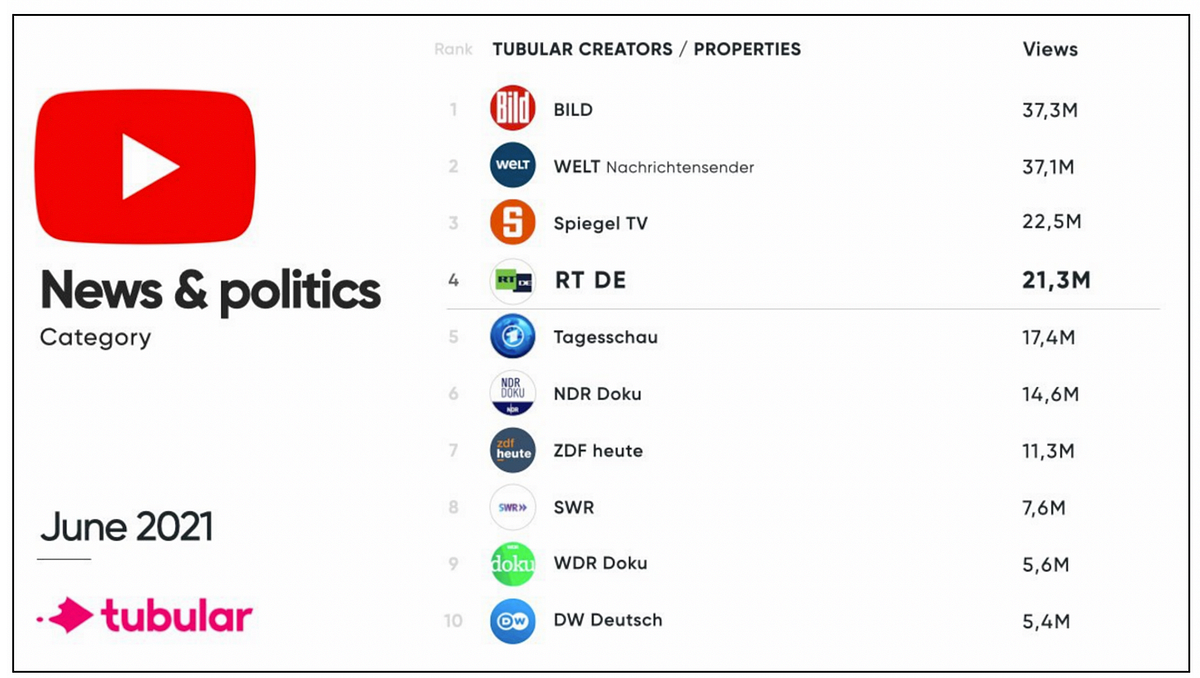
Using social media listening tool BuzzSumo, the DFRLab found the statistics around the top 10 YouTube channels were somewhat different from Tubular Labs statistics quoted by Toktosunova. Subsequently, the DFRLab verified the BuzzSumo data manually on YouTube for most of the analyzed TV channels and found that the difference between figures obtained from Tubular and BuzzSumo were not significant enough to change the overall ranking.
Tubular Labs figures, however, do not provide a full picture, as they do not consider the posting activity of any given YouTube channel, one of the key determinants of a view count. More specifically, RT DE and other channels that follow RT DE in Tubular Labs ranking uploaded a drastically different number of videos to the platform in June 2021, ranging from 12 videos in case of DWR Doku channel to RT DE’s 637. The number of videos posted to any given YouTube channel drives the potential to reach higher number of views, as there are more opportunities for an audience to repeatedly reengage by watching new videos. In view of this, comparing views per video of each channel is a useful metric with which to compare performance beyond just relying on of total views. To that end, the DFRLab divided the total views garnered by each outlet in June 2021 by the number of videos each uploaded during the same month. Following this recalibration, NDR Doku was highest in terms of average number of views per video, while RT DE was the last one among seven selected channels.
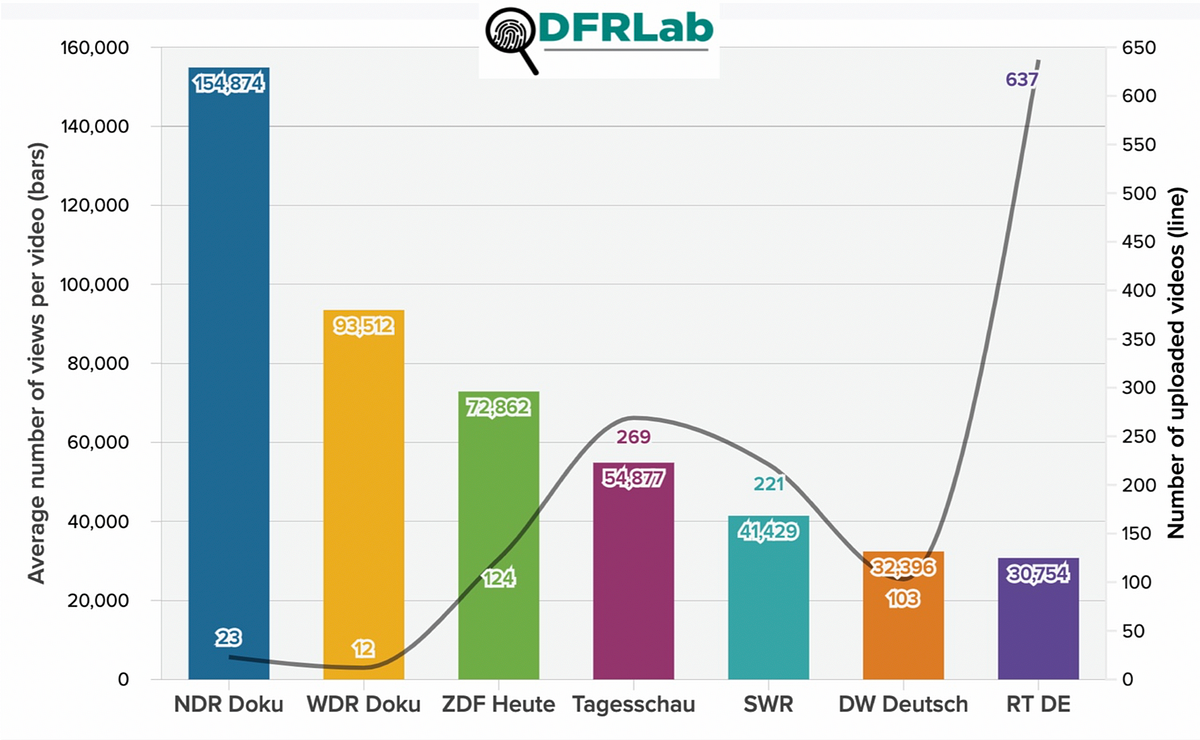
The DFRLab also examined total interactions (sum of comments, likes, and dislikes) on YouTube videos uploaded by each of these channels in June 2021. Interactions can be seen as a sign that audience were more invested in the substance of the content than total viewership, which is simply the count of the number of plays a video has received. However, interactions can also be inflated artificially using automation, but the DFRLab was unable to confirm whether interactions on videos belonging to any of these channels had been artificially inflated. Tagesshau was excluded from the interactions count, as the outlet had the ability to comment turned off on most of its videos, and thus its videos did not gather the same type of interactions as other channels. A BuzzSumo query showed that ZDF Heute garnered the highest number of interactions in June 2021 and that RT DE was fourth among the selected six channels in terms of interactions per video.
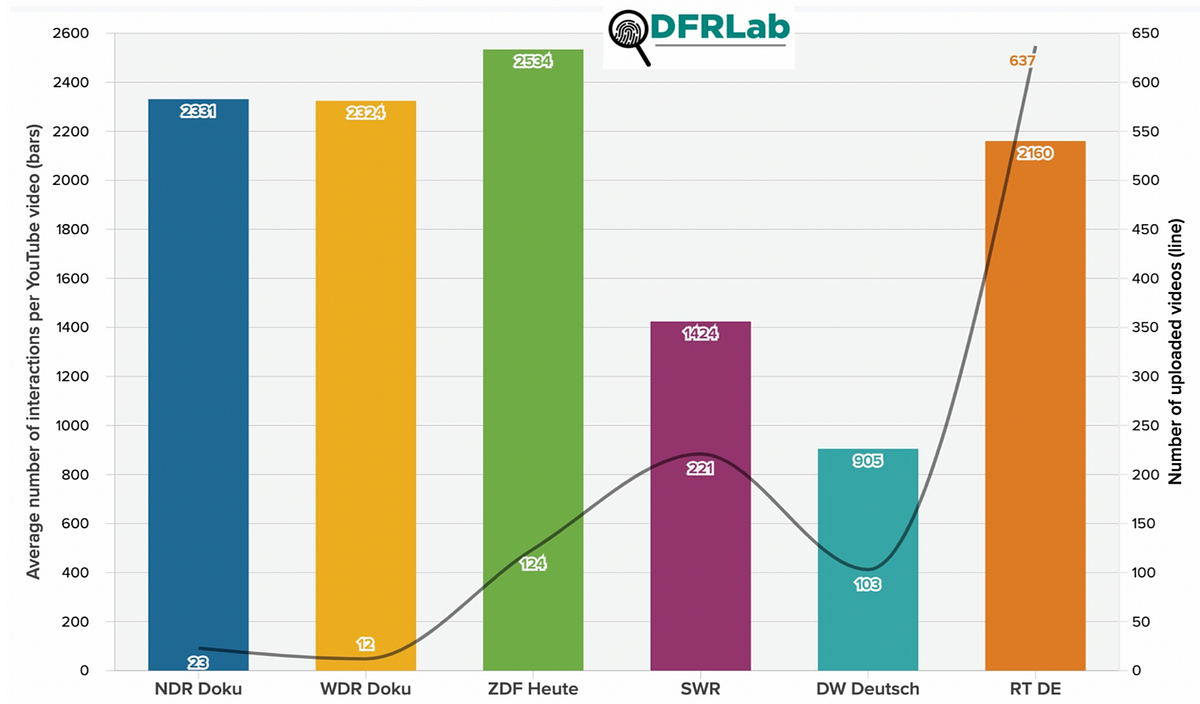
The DFRLab also used Social Bakers, an analytical tool that tracks key metrics across various digital channels, to obtain insights on total watched hours for each channel’s videos from the day of channel creation up until August 1, 2021. RT DE videos garnered the highest number of total watched hours among all analyzed channels, but if we divide total watched hours by the number of uploaded videos per channel, RT DE comes third. More specifically, RT DE uploaded 26,232 videos from the creation of its channel on June 11, 2014, to August 1, 2021, and these videos were watched for more than 224 million hours in total. If we divide number of total watched hours by the number of uploaded videos, we can see that RT DE videos were watched for 8,565 hours on average. The Social Bakers query did not provide results for three channels: Tagesschau, WDR Doku, and NDR Doku.
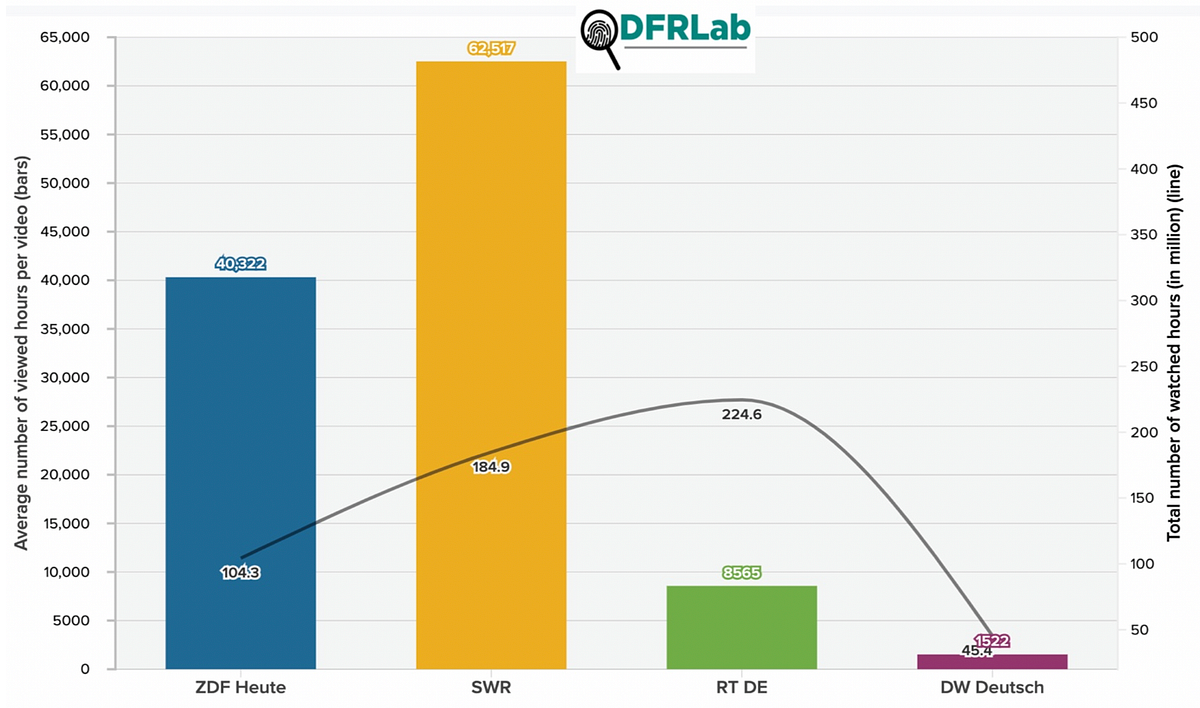
The DFRLab also found that while RT DE uploaded the highest number of videos since the creation of its channel, it came sixth in terms of average number of views per video among all analyzed seven channels throughout the existence of these channels, while Deutsche Welle channel garnered the lowest number of views per video on average.

Analyzing performance of RT DE and German TV channels on Facebook
Toktosunova’s Telegram post also included Tubular Labs’ statistics for Facebook, which showed RT DE as fifth in the top 10 Facebook pages in terms of views of videos posted directly to the platform. The DFRLab used Facebook-owned analytics tool CrowdTangle and found discrepancies with Tubular Labs figures, but the difference again did not affect the overall ranking. There were five German TV channels after RT DE in the ranking of which the DFRLab analyzed their respective Facebook pages: Der Postillon, SWR Aktuell, quer, SPIEGEL.TV, and Die Frage.

A CrowdTangle query showed that even though RT DE uploaded significantly more videos (607) to Facebook in June 2021 than other analyzed outlets, it garnered the least amount of views per video on average. Moreover, three channels (Der Postillon, quer, and Die Frage) garnered many more interactions in June than RT DE, and only two channels lagged behind RT DE in terms of total interactions. It showed that, even though RT DE was more active in terms of posting videos to Facebook, it still garnered fewer views per video on average.
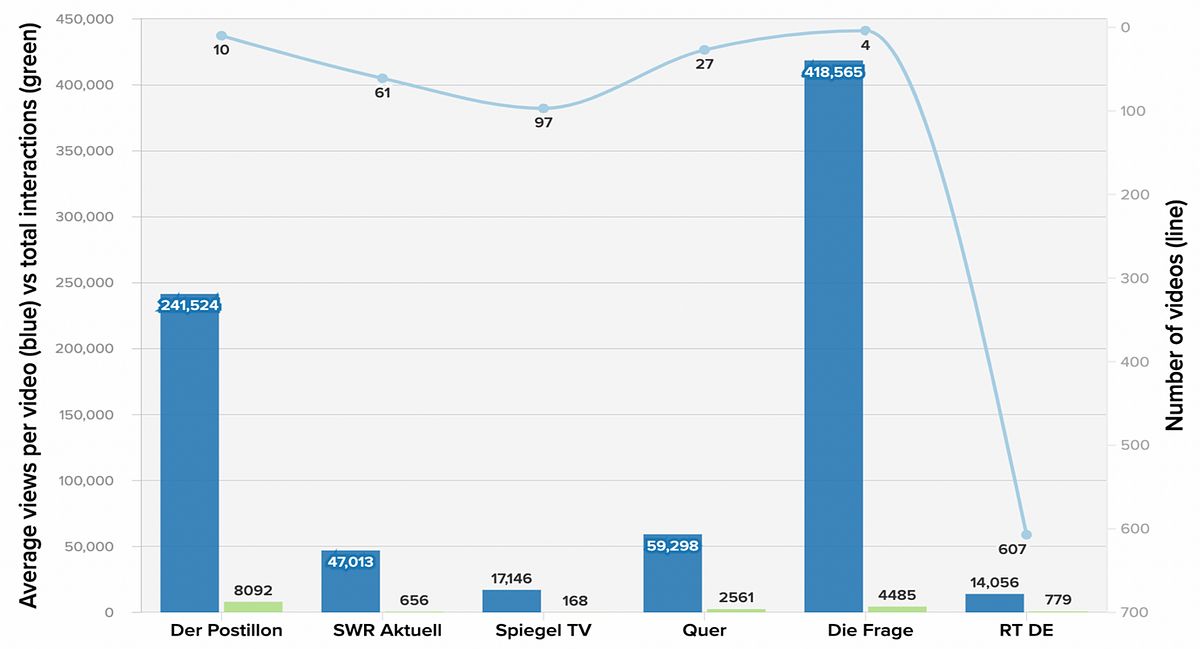
Conclusion
DFRLab analysis showed that while RT DE’s respective YouTube channel and Facebook page garnered more views than some local German outlets in June 2021, its overall performance across other metrics mixed. The fact that RT DE received more views on its significantly higher quantity of videos than the rest of the analyzed channels does not automatically make it more popular, as implied by the outlet’s editor-in-chief; it just makes it more active. In using just that single statistic, however, the editor-in-chief hoped to give the German subsidiary more claims to legitimacy and influence than would otherwise be understood when the full picture is conveyed.
Givi Gigitashvili is a Research Assistant, Caucasus, with the Digital Forensic Research Lab.
Cite this case study:
Givi Gigitashvili, “RT DE puts spin on user analytics to claim it outperforms German TV stations online,” Digital Forensic Research Lab (DFRLab), September 3, 2021, https://medium.com/dfrlab/rt-de-puts-spin-on-user-analytics-to-claim-it-outperforms-german-tv-stations-online-f239fee0ddcc.
Follow along for more in-depth analysis from our #DigitalSherlocks.

